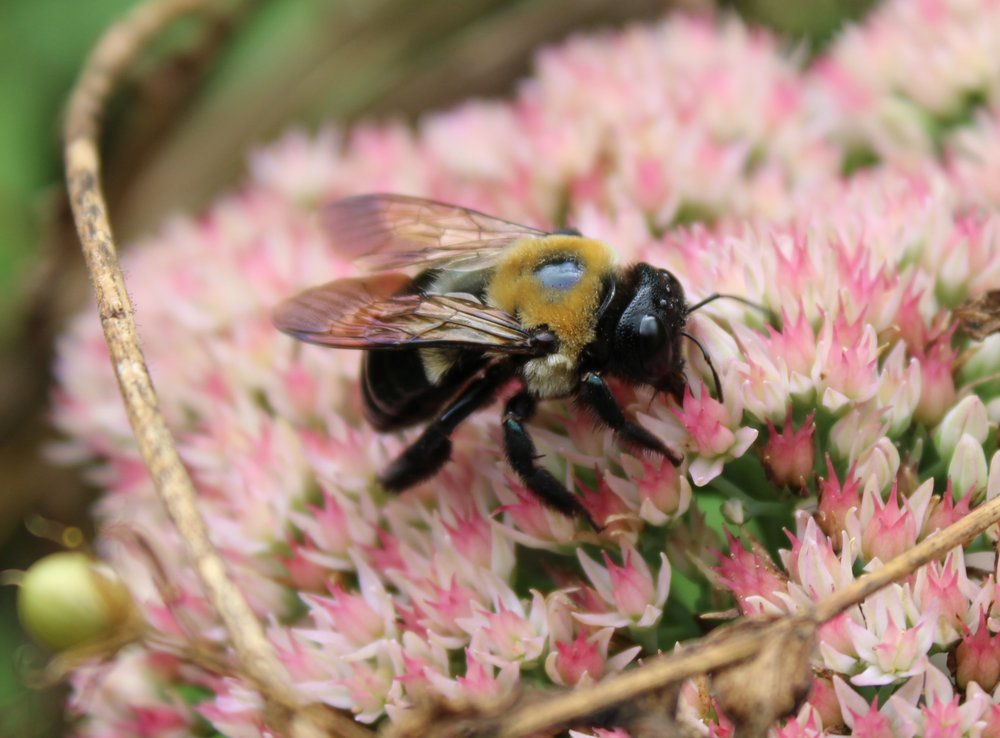Posted: January 28, 2021
Mace Vaughan, Xerces Society Pollinator Conservation Program Co-Director, highlights programs that support bee conservation as part of PSU Entomology's Global Perspectives in IPPM seminar series.

Photo by J. Lana Mejias
Pollinator populations are in decline across many parts of the world as pollinators face pressures from habitat loss, disease, pesticide usage, and climate change. These declines are not just limited to domestic honey bees but are also impacting native pollinators, which place agricultural industries and national food security at risk.
As concerns over pollinator declines continue, growers are increasingly incorporating integrated pest management practices (IPM) into their operations. Integrated pest management combines biological, chemical and cultural tools to reduce damage from pests while also minimizing economic, health and environmental risks to beneficial insects and others. This science-based, informed approach can reduce costs and labor for growers, while also mitigating risks posed to beneficial insects such as pollinators, parasitoids and predators of pest insects.
At the leading edge of new and developing IPM initiatives are researchers like Mace Vaughan with The Xerces Society. The Xerces Society's Mission is to protect wildlife by conserving invertebrates and their habitat. Within the Society, Vaughan serves as Co-Director of the Pollinator and Ag Biodiversity Program and as a Conservation Entomologist and Partner Biologist with the USDA Natural Resources Conservation Service (NRCS). Vaughan leads a team of 22 researchers based across the United States.
The Xerces Society works closely with farmers to provide instruction on invertebrate conservation, which in 2016 led to the Bee Better Certified program. Through this program, growers are evaluated against a comprehensive set of production standards developed by The Xerces Society to rate how well they are promoting pollinators on their farms. Bee Better Certified farmers create improved pollinator conditions by creating floral habitat, providing nesting resources to native pollinators, and reducing pollinator exposure to pesticides. To date, over 20,000 acres of farmland, representing over 13 farms, have been certified.
The Xerces Society has also been instrumental in working with the Natural Resources Conservation Service (NRCS) to develop a cost-share program developed through the Environmental Quality Incentives Program. The program incentivizes growers to adopt management practices outlined in the Pest Management Conservation System, which promotes many classical approaches towards IPM, such as prevention, avoidance, monitoring, and suppression. To get financial assistance, growers must document the current methods they are practicing and what new techniques they plan to add to their management program.
To aid the NRCS agents and the growers they assist in better implementing the Pest Management Conservation System practice; Vaughan drafted a framework outlining a 4- step process. Growers should first identify their pollinator concerns. Then they should determine if they are utilizing pesticides that are of bee health concern, how pollinators may be coming into contact with these pesticides, and what preventatives they can put in place to ultimately minimize pollinator exposure. The framework includes a table where growers can score their mitigation techniques to document they are making meaningful changes in their practices.
Vaughan finds growers are most successful with these practices when they are tailored to be more crop and region-specific. To accomplish this, the NRCS and The Xerces Society partners with local extension agents to develop customized alternative pest management strategies for growers. For example, they worked with University of Maine to develop a set of guidelines for IPPM in blueberries. These partnerships have been expanding to other portions of the country, such as developing guidelines for apple crops in Oregon in conjunction with Oregon State University.
The implementation of agriculturally-focused conservation programs such as these show promise for the safety, abundance and diversity of bees on farms, while sustainably improving crop production. Learn more about the programs discussed here by visiting the sites linked above or by watching Mace's lecture on NGO perspectives of IPPM on the Penn State Insect Biodiversity Center website.

